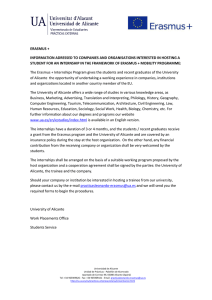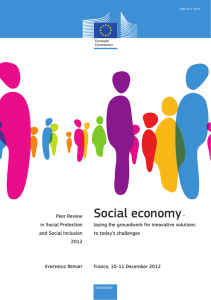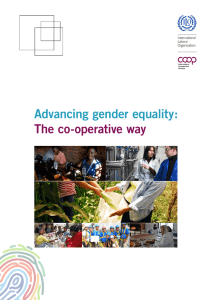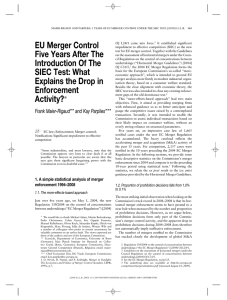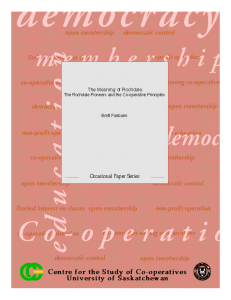Company valuation methods: applying dynamic analogical
Anuncio
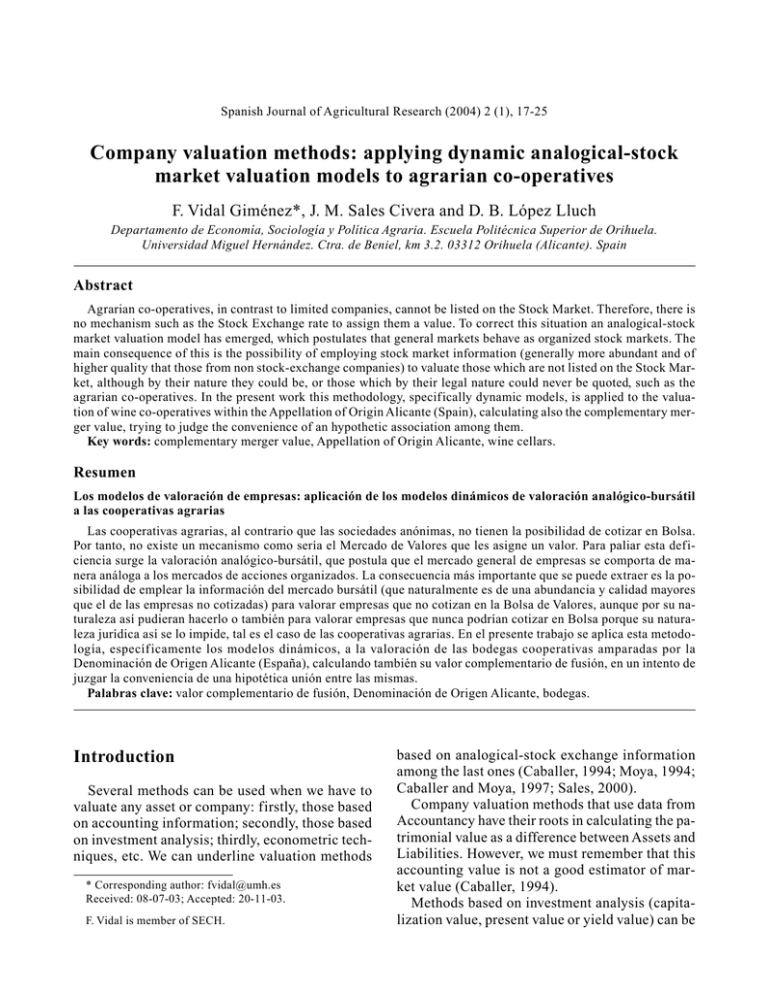
Spanish Journal of Agricultural Research (2004) 2 (1), 17-25 Company valuation methods: applying dynamic analogical-stock market valuation models to agrarian co-operatives F. Vidal Giménez*, J. M. Sales Civera and D. B. López Lluch Departamento de Economía, Sociología y Política Agraria. Escuela Politécnica Superior de Orihuela. Universidad Miguel Hernández. Ctra. de Beniel, km 3.2. 03312 Orihuela (Alicante). Spain Abstract Agrarian co-operatives, in contrast to limited companies, cannot be listed on the Stock Market. Therefore, there is no mechanism such as the Stock Exchange rate to assign them a value. To correct this situation an analogical-stock market valuation model has emerged, which postulates that general markets behave as organized stock markets. The main consequence of this is the possibility of employing stock market information (generally more abundant and of higher quality that those from non stock-exchange companies) to valuate those which are not listed on the Stock Market, although by their nature they could be, or those which by their legal nature could never be quoted, such as the agrarian co-operatives. In the present work this methodology, specifically dynamic models, is applied to the valuation of wine co-operatives within the Appellation of Origin Alicante (Spain), calculating also the complementary merger value, trying to judge the convenience of an hypothetic association among them. Key words: complementary merger value, Appellation of Origin Alicante, wine cellars. Resumen Los modelos de valoración de empresas: aplicación de los modelos dinámicos de valoración analógico-bursátil a las cooperativas agrarias Las cooperativas agrarias, al contrario que las sociedades anónimas, no tienen la posibilidad de cotizar en Bolsa. Por tanto, no existe un mecanismo como sería el Mercado de Valores que les asigne un valor. Para paliar esta deficiencia surge la valoración analógico-bursátil, que postula que el mercado general de empresas se comporta de manera análoga a los mercados de acciones organizados. La consecuencia más importante que se puede extraer es la posibilidad de emplear la información del mercado bursátil (que naturalmente es de una abundancia y calidad mayores que el de las empresas no cotizadas) para valorar empresas que no cotizan en la Bolsa de Valores, aunque por su naturaleza así pudieran hacerlo o también para valorar empresas que nunca podrían cotizar en Bolsa porque su naturaleza jurídica así se lo impide, tal es el caso de las cooperativas agrarias. En el presente trabajo se aplica esta metodología, específ icamente los modelos dinámicos, a la valoración de las bodegas cooperativas amparadas por la Denominación de Origen Alicante (España), calculando también su valor complementario de fusión, en un intento de juzgar la conveniencia de una hipotética unión entre las mismas. Palabras clave: valor complementario de fusión, Denominación de Origen Alicante, bodegas. Introduction Several methods can be used when we have to valuate any asset or company: firstly, those based on accounting information; secondly, those based on investment analysis; thirdly, econometric techniques, etc. We can underline valuation methods * Corresponding author: [email protected] Received: 08-07-03; Accepted: 20-11-03. F. Vidal is member of SECH. based on analogical-stock exchange information among the last ones (Caballer, 1994; Moya, 1994; Caballer and Moya, 1997; Sales, 2000). Company valuation methods that use data from Accountancy have their roots in calculating the patrimonial value as a difference between Assets and Liabilities. However, we must remember that this accounting value is not a good estimator of market value (Caballer, 1994). Methods based on investment analysis (capitalization value, present value or yield value) can be 18 F. Vidal Giménez et al. / Span J Agric Res (2004) 2 (1), 17-25 good estimators of the market value if we locate the decision making process about investments in an efficient market environment. So, to estimate the year free cash flows, and their predictable evolution for relatively short periods of time, is not a difficult task if we know the Profit and Loss Account and the company´s plans for the future. Nevertheless, it has to be noted that we are dealing with a prediction for the future and we must accept some hypotheses which are impossible to be proved in the present. The use of these models, as CAPM (Capital Assets Price Model) or APT (Arbitrage Pricing Theory), is not supported by the empiric evidence (Fama and French, 1992). Moreover, other authors have shown the inconsistency of the Beta calculation (Ballarin et al., 1994). Otherwise, the use of concepts related to value creation for shareholders, as EVA (Economic Value Added), Economic Profit and MVA (Market Value Added) will present the same problems that the cash flows discount (Sales, 2000). The updating index estimation implies a much more difficult task, due to the fact that the financial market as a whole does not behave in an efficient way. Moreover, investments whose updating index is known are not homogeneous. This leads us to the possibility of electing this updating index among a relatively large set of values. This makes the final result very sensitive. Something very similar happens when we decide the investment term. This decision becomes harder and harder due to the technological updating. The updating index has to be chosen by comparing with other investments and the term must be fixed among several possibilities without rigorous criteria to do it (Caballer and Moya, 1998). As it has been said before, classic valuation methods arrive to expressions as V =aX, where X is a variable linked to the yield. This expression could also be obtained through regression methods, it would be enough to choose the appropiate variable and to adjust a regression which goes through the coordinate’s origin. But if more variables are employed (as long as they are not correlated among them), and the equation is provided with an independent term (multivariate models), a model will be obtained with a higher explanatory power and a higher likelihood (bearing in mind, for instance, the existence of no profit or although a negative one, does not mean a null or negative valuation of the company). Thus, regression methods try to estimate variable behaviour, and market value as a mathematical function of other explanatory variables. If variables have correctly been chosen, and functions are adequate to explain the relationship between the market value variable and those treated as explanatory variables, the application of these econometric methods depends on the existence of a business transaction database. The lack of broad enough databases is the biggest difficulty for applying these methods, due to the fact that the number of business transactions is not very high and data are not systematically recorded (Sales, 2000). The analogical-stock exchange method has been formulated and developed in order to overcome the lack of databases and be in the position to apply this methodology with a minimal operating level. This valuation method needs the acceptance of three hypotheses (Caballer and Moya, 1997): — The stock exchange company value, as the sum of each type of company stock quotation multiplied by their number, is a company market value estimator. — The stock exchange value or market value, if we accept the first hypothesis, can be explained as an endogenous variable starting from the companies economical and financial features (explicative variables in regression models). — The companies market is similar to stock exchange market. This methodology, that has been used before in different sectors: banks (Moya, 1996; Caballer et al., 1998), energy (Caballer and Moya, 1995) and agrifood companies (Moya and Oltra, 1993; Caballer and Moya, 1998; Sales, 2002), has two main advantages: it is simple and its hypotheses are more consistent than others. Moreover it allows one to valuate co-operative companies in a similar way with other companies for which we have enough information. This partly overlooks the problem of the lack of tools to analyse the behaviour of these associative companies, which due to their legal typology cannot act in the stock exchange market. One objective of this paper is to obtain a global value for the wine co-operatives within the Appellation of Origin Alicante, one of the 60 wine Spanish Appellations of Origin (D.O.). It comprises 14,254 ha, 3,134 wine farmers and production of 112,463 hl in 2002-2003 campaign (about a 2% of national f igures). The D.O. Alicante gathers 15 Valuation of agrarian co-operatives first tier wine producer co-operatives, that suppose the 99% of the winegrowers and more than 97% of the area and production of this D.O. Two thirds of the commercialized volume goes to the Spanish market (with a 34% sales increase in the last decade). The rest is exported, mainly to the European Union (with a 61% sales increase in the same period). The sales are composed of: 78% red wine, 10% white wine, 9% rosé wine, and the rest is brandy (Martínez-Carrasco, 2002). It must be remarked that at the present time exists in the D.O. Alicante a second tier commercialization co-operative, Bodegas Cooperativas de la Provincia de Alicante (BOCOPA), constituted by eight f irst tier co-operatives, which gather around the 60% in number of winegrowers as well as in area and production volume. Other objective is to calculate a merger value of D.O. co-operatives, trying to judge the convenience of an hypothetic association among them. A cooperatives complementary merger is also calculated, as the difference between the stock exchange value of the company that would result from an hypothetical merger of these co-operatives and the sum of co-operatives individual values. Material and Methods Opposite to static analogical-stock exchange valuation models (Caballer, 1994; Caballer and Moya, 1997; Caballer et al., 1998), this work has opted to use a dynamic valuation model that allows us to relate the stock exchange value with economic-financial variables of the analized companies and also with external indexes that validate these equations for different periods of time. A diagonal analysis of agrifood companies quoted in the Spanish Stock Market has been carried out. For this purpose, we used the average stock market for the last term of each year, economicfinancial variables and the average Madrid Stock Exchange Food Sector Index (IABM) for the last term. This work embraces an eight year period (1994-2001). A company with data for all the period is considered as eight different companies in order to get a higher effectiveness in the calculation process. In this way, a regression equation is estimated where business stock value is explained through 19 economic-financial variables and IABM. So, it is possible to introduce data from any company (although it is not a quoted company) and get its analogical-stock value. The sole condition is the economic and f inancial structure homogeneity between the company to value and the companies that are analysed (Sales, 2000). So, with only a regression we would have calculated the stock exchange value for any company, in any last year, and we could make a future forecast, only by replacing the expect value of this index in the resultant equation. Thus, and always that exist the homogeneity conditions in the economicfinancial structure, we can valuate in the present and/or in the future any agrifood company, although it does not quote in the Stock Market. We have opted for the Stock Exchange Food Sector Index as explanatory variable, instead of other variables that have influence in the company stock exchange value, as interest rate, inflation rate or GNP growth, because this index also gather these variables, and it displays a very high correlation with all of them: –82% and –75,7% with three years bonds yield and Madrid Interbank Oferred Rate (MIBOR), respectively (Sales, 2000). General dynamic valuation model used, calculated using information about agrifood companies quoted in the Spanish stock exchange market during the period 1994 – 2001, is the following: VB = b0 f0 (Ia) + b1 f1 (Ia)X1 + ... + bn f0 (Ia) Xn + e (1) where: VB = mean stock exchange value for the last year term = regression coefficients bi fi (Ia) = functions of Madrid Stock Exchange Food Sector Index Xi = model explanatory variables e = error term One of the obstacles that the model must overcome is the interdependency among explanatory variables. This complicates the empirical determination of the variable contribution to the observed stock exchange value variation. In order to avoid this problem we must comply with the following steps. Firstly we observe the correlation level among explanatory variables related to the market value variable (V B) in a correlation matrix. Secondly a principal components factor analysis is done with the purpose of obtaining the 20 F. Vidal Giménez et al. / Span J Agric Res (2004) 2 (1), 17-25 Table 1. Explanatory variables used in the model rotated factors matrix. In this paper we choose the orthogonal rotation, particularly the so called Varimax method, obtaining the factor axis maximizing the extraction sums of squared loadings variance by each factor (Cuadras, 1981; Darling and Tamura, 1981). Then, a factorial regression between stock exchange value (VB) and rotated factors (Fi) is done. These factors act as explanatory variables. So, it is possible to select those significant factors when explain relatively lot amounts of stock exchange variance. AT AU BB BBAT BN BNRP CF F VAT Ia RAI GF GFE IN RP RPERM RPA VA VAF VB = α1F1 + α2F2 + …. + αnFn The definitive regression is formulated at this stage. Factorial regression components are substituted by variables which show the highest correlation in each factor. This allows the reduction of multicolinearity among explanatory variables to the minimum. At the end, the hypothesis of the economic-financial structure homogeneity is tested between explicative variables of stock exchange quoted companies (SEQC) and the companies that do not (UC). A variance analysis is then constructed (ANOVA). If it can be considered that no variable statistically significant difference exists between SEQC and UC, regression equations to value UC could automatically be used. If not, the wrong variable should be changed for another from the same factor that fulfils the behaviour homogeneity condition between both companies groups (SEQC and UC). Variable substitution brings a minimum explanatory capability loss. Explanatory variables, that according to main trends of fundamental analysis bear upon the valuation model proposed in this paper, can be seen in Table 1. This information has been obtained from = Total Assets (106 €) = Equity/Fixed Liability (%) = Gross Margin (106 €) = Economic Profitability (%) = Net Margin (106 €) = Financial Yield (%) = Net Cash Flow (106 €) = Sales (106 €) = Sales/Total Assets (%) = Madrid Stock Exchange Food Sector Index = Turnover/Net Fixed Assets (%) = Financial Costs (106 €) = GF/Receivable Assets (%) = Net Fixed Assets (106 €) = Equity (106 €) = Long Term Assets (106 €) = Equity/Total Assets (%) = Added Value (106 €) = Added Value/Sales (%) Table 2. Stock exchange value (VB) Pearson* correlations with main explanatory variables for Madrid Stock Exchange Food Sector Index companies AT BB F BN CF RP IN RPERM 0.858 0.856 0.851 0.849 0.839 0.790 0.761 0.744 * Significant coefficients at 1% level of confidence in all cases. the Balance Sheet and Profit and Loss Account of Madrid Stock Exchange Food Sector Index companies in the period 1994-2001 (CNMV, 2002). When the multiple correlation matrix is calculated, it can be observed that the most correlated variables with stock exchange value (VB) are: AT, BB, F, BN, CF, RP, IN and RPERM (Table 2). Furthermore, the high correlation among variables is evident (Table 3). This makes it impossible to act together in a regression model (multicolinearity problem). Table 3. Correlations for explanatory variables of Madrid Stock Exchange Food Sector Index companies AT BB F BN CF RP IN RPERM AT BB F BN CF RP IN RPERM 1.000 ** ** ** ** ** ** ** 0.807 1.000 ** ** ** ** ** ** 0.867 0.883 1.000 ** ** ** ** ** 0.806 0.991 0.866 1.000 ** ** ** ** 0.841 0.942 0.860 0.944 1.000 ** ** ** 0.884 0.868 0.822 0.856 0.834 1.000 ** ** 0.828 0.836 0.768 0.804 0.792 0.953 1.000 ** 0.839 0.859 0.788 0.841 0.815 0.987 0.969 1.000 Valuation of agrarian co-operatives Table 4. Rescaled component matrix for explanatory variables of Madrid Stock Exchange Food Sector Index companies 21 Table 6. Total Asset (AT) cluster analysis for Madrid Stock Exchange Food Sector Index companies. Cluster final centre Cluster Factors AT RPERM RP IN BB CF VA BN F GF AU RPA BBAT BNRP VAT RAI VAF GFE 1 2 3 4 0.969 0.964 0.962 0.957 0.928 0.924 0.920 0.911 0.859 0.640 0.003 –0.159 0.142 0.091 0.209 0.132 –0.151 –0.195 –0.024 0.019 0.045 –0.067 0.142 0.135 –0.050 0.195 –0.014 –0.273 0.858 0.806 0.720 0.598 0.044 0.106 0.107 0.046 0.026 0.015 0.075 0.032 0.150 0.187 0.202 0.160 0.352 –0.110 0.134 –0.118 0.081 –0.040 0.876 0.841 –0.699 –0.045 0.060 0.018 0.029 0.090 –0.167 –0.174 0.000 –0.185 –0.125 0.519 0.002 0.172 –0.312 0.001 –0.074 –0.227 –0.206 0.861 In order to avoid this problem, a principal components factor analysis is developed (Table 4). This analysis, considering an eigenvalue higher than unit, reduce the 18 initial variables to four principal factors that explain the 80% of total variance (Table 5). Factor 1 contains only variables in absolute value, which are referred to company size (AT, IN), capital requirements (RP, RPERM) and gain (F, BB, BN, etc.). Factor 2 is refered to equity weight and the company economic-financial profitability (BBAT and BNRP), all of them ratio variables. Table 5. Factor analysis variance explained for Madrid Stock Exchange Food Sector Index companies Factors Extraction sums of squared loadings Total Factor 1 (F1): AT, RPERM, RP, IN, BB, CF, VA, BN, F, GF Factor 2 (F2): AU, RPA, BBAT, BNRP Factor (F3): VAT, RAI, VAF Factor (F4): GFE % of Cumulative variance % 1 (120 companies) 2 (78 companies) 5.55 3.56 Ln AT Factor 3 represents the efficiency in entrepreneurial management (VAT, RAI or VAF), while Factor 4 is refered to financial costs (GFE), both ratio variables too. In factorial regression, explanatory variables are the components that have been extracted in the previous factor analysis (t-statistics are in parenthesis): VB = 236.835 + 423.134 F1 + 24.913 F2 + (12.087) (21.539) (1.268) (2) R2 = 0.723 + 76.418 F3 – 103.747 F4 (3.890) (–5.281) As can be noted from t-student values of previous expression, factors with higher explanatory loadings in stock market value calculation are Factor 1 (mainly in its size component), followed by Factor 4 and Factor 3 (referred to efficiency in entrepreneurial management). In order to avoid homocedasticity, SEQC are separated to two groups through a cluster analysis. Total Asset Naperian logarithm is used as the variable because company size must be the separator between big and small companies. A logarithmic scale is employed to soften the scale change (Sales, 2000). The frontier between both groups is located around 108 € (Tables 6 and 7). At this stage, definitive regressions are calculated for both groups of companies (SEQC) from the cluster analysis (Table 6); factors are substituted by variables (one per factor) with the highest correlation (thus multicolinearity is overcome). The following results are obtained for big companies [AT > 108 €, (3)] and small companies [AT < 108 €, (4)] (t-statistics are in parenthesis): Table 7. ANOVA for AT cluster analysis for Madrid Stock Exchange Food Sector Index companies 8.256 45.868 45.868 2.450 13.610 59.478 2.308 1.366 12.824 7.587 72.302 79.889 Cluster Mean square Ln AT 182.764 Error F df Mean square df 1 0.493 196 Sig. 370.041 0.000 22 F. Vidal Giménez et al. / Span J Agric Res (2004) 2 (1), 17-25 Table 8. SEQC and co-operatives ANOVA results for RPA, VAT and GFA Sum of squares df Mean square F Sig. RPA Inter-groups Intra-groups Total 28,313.631 69,150.546 97,464.177 1 197 198 28,313.731 351.018 80.662 0.000 VAF Inter-groups Intra-groups Total 44,815.622 57,463.127 102,278.749 1 197 198 44,815.622 291.691 153.641 0.000 GFE Inter-groups Intra-groups Total 1,542.860 2,885.260 4,428.122 1 197 198 1,542.860 14.646 105.344 0.000 VB = –198.335 + 0.003 Ia AT + 5.757 10-8Ia AT 2 + (–2.971) (7.591) (21.290) (3) + 0.824 VAT + 1.487 AU R2 = 0.937 (3.780) (2.012) lnVB = –1.968 + 1.065 lnAT + 0.002 Ia + (–7.763) (31.631) (5.849) (4) + 0.013 RPA + 0.008 VAF – 0.019 GFE R2 = 0.853 (6.918) (5.365) (–2.436) where: VB = Stock exchange value (106 €) AT = Total Assets (106 €) VAT = Sales / Total Assets (%) AU = Equity/Long Term Assets (%) RPA = Equity/Total Assets (%) GFE = Financial Costs/Receivable Assets (%) = Madrid Stock Exchange Food Sector Index Ia All wine co-operatives are considered small companies (AT < 108 €), so regression (4) is used. Furthermore, we must analyse the existence of significant differences (ANOVA) between SEQC and these co-operatives, for RPA, VAF and GFE. There are significant differences for all of them, so they can not be used in the model (Table 8). As we can’t use previous variables, as they significantly differ between groups (SEQC and co-ope- ratives), we must replace them by other variables of the same factor, which have not this problem. In our case, after some calculations, variables that comply with this condition and also show the best adjustment are: AU (Equity/Fixed Liability) from Factor 2 and VAT (Sales/Total Assets) from Factor 3 (ANOVA results that validate the choice of these variables are shown in Table 9). The regression equation that replace (4) expression is the following (it can be observed a minimum explanatory capability loss): lnVB = –1.690 + 1.020 lnAT + 0.002 Ia + (–6.688) (28.783) (6.220) 2 + 0.012 AU + 0.002 VAT R = 0.828 (5) (6.240) (3.975) where: VB = Stock exchange value (106 €) AT = Total Assets (106 €) AU = Equity/Fixed Liability (%) VAT = Sales/Total Assets (%) = Madrid Stock Exchange Food Sector Index Ia Results In Table 10 we can see the analogical-stock exchange value evolution for D.O. Alicante co-ope- Table 9. SEQC and co-operatives ANOVA results for AU and VAT Sum of squares df Mean square F Sig. AU Inter-groups Intra-groups Total 774.315 221,219.968 221,994.283 1 197 198 774.315 1,122.944 0.690 0.407 VAT Inter-groups Intra-groups Total 3,939.565 896,429.588 900,369.153 1 197 198 3,939.565 4,550.404 0.866 0.353 Valuation of agrarian co-operatives 23 Table 10. Analogical-stock exchange value evolution for D.O. Alicante co-operatives from 1994 to 2001 (106 €) Co-ops 1994 1995 1996 1997 1998 1999 2000 2001 1 2 3 4 5 6 7 8 9 10 11 12 13 14 15 0.469 0.089 0.566 0.024 0.513 0.869 0.187 0.723 0.834 1.153 0.305 0.272 0.151 0.546 0.511 0.522 0.137 0.505 0.038 0.542 0.514 0.162 0.834 0.977 1.194 0.776 0.266 0.168 0.435 0.538 0.547 0.117 0.563 0.039 0.537 0.376 0.209 0.717 1.152 1.352 0.670 0.165 0.199 0.394 0.536 0.956 0.183 0.854 0.099 0.275 2.338 0.488 1.025 1.257 1.941 0.457 0.366 0.293 0.929 0.704 1.292 0.369 1.333 0.233 0.695 2.215 0.690 1.367 2.047 3.485 1.632 0.534 0.471 1.527 1.133 1.322 0.433 1.455 0.328 1.304 1.869 0.819 1.521 2.610 4.538 0.444 0.667 0.557 0.956 1.615 1.703 0.365 1.441 0.388 1.575 4.075 0.557 1.305 1.930 4.429 0.731 0.493 0.610 0.767 1.397 1.456 0.335 1.454 0.390 1.464 3.018 0.825 1.231 0.789 3.924 0.674 0.434 0.549 0.871 1.770 7.212 7.608 7.573 12.165 19.023 20.438 21.766 19.184 Total co–ops value ratives from 1994 to 2001, as well as a total yearly value work out as the sum of all co-operatives value. We can appreciate the significant increase of these values during the last eight years. Table 11 shows the D.O. Alicante co-operatives complementary merger value from 1994 to 2001. This value is the difference between the stock exchange value of the company that would result from an hypothetical merger of these co-operatives and the sum of co-operatives individual values (Table 10). This concept is important in order to know if value is created or destroyed in the concentration process. In the case of the wine co-operatives of D.O. Alicante, complementary merger value is always positive (Table 11), with a signifiTable 11. Merger values for D.O. Alicante co-operatives from 1994 to 2001 (106 €) Year Hypothetical co-operative merger value 1994 1995 1996 1997 1998 1999 2000 2001 9.765 10.536 10.044 16.272 25.265 26.029 28.301 23.939 Sum of co-operatives Complementary individual merger value value 7.211 7.609 7.574 12.164 19.023 20.438 21.765 19.183 2.553 2.927 2.470 4.108 6.242 5.590 6.536 4.756 cant increase in the period too, which at first advice us a merger among them. Other possibility in order to decide the merger suitability among companies is the use of Tobin’s q, ratio that relate company market value (valued by VB) with a book value (usually a replacement cost, although in that case it is valued by co-operatives equities value). If the value of the q ratio is higher than unit this means value creation for the co-operative member, meanwhile values lower than unit mean value loss, because in that case market value is lower than its equity value. In our case, the calculated q value is not exactly de Tobin’s q but an approach, where the replacement cost is replaced by the asset value. This value is always higher for an hypothetical co-operative merger than for the sum of co-operatives individually (Table 12). This difference (as a relative value) is other way to show the value creation that for members mean an hypothetical merger among these co-operatives. If we draw the evolution of D.O. Alicante cooperatives value, as the sum of co-operatives individual value and as an hypothetical co-operative merger value, we can appreciate the similar performance of Madrid Stock Exchange Food Sector Index and these values (Figure 1). Regarding complementary merger value, it can be observed how an hypothetical co-operatives merger has a higher value than first tier co-opera- 24 F. Vidal Giménez et al. / Span J Agric Res (2004) 2 (1), 17-25 Table 12. Tobin’s q for an hypothetical co-operatives merger and for the sum of individual co-operatives from 1994 to 2001 (106 €) Hypothetical co-ops merger Sum of individual co-ops ∆ Value creation (%) 1994 1995 1996 1997 1998 1999 2000 2001 2.732 2.018 35.405 2.626 1.897 38.475 2.412 1.819 32.610 3.569 2.668 33.771 5.271 3.969 32.815 4.379 3.439 27.352 4.875 3.749 30.032 3.809 3.053 24.794 tives acting on their own (graphically it will the area comprised between both co-operatives value lines from 1994 to 2001, Figure 1). This value has increased continuously during the first half of the period, fluctuating later around five million euros. By relative value, an hypothetical merger will mean a value creation with respect to the original situation around a 30% in the period (Table 12). This would prove the suitability, as far as value creation, of a merger process for D.O. Alicante first tier wine co-operatives. However, as it has been said before, nowadays the chosen solution for one half of D.O. Alicante co-operatives, is not the merger among them, but also the joint commercialization of their production through a second tier commercialization co operative (BOCOPA). Discussion 700 30 600 25 500 20 400 15 300 10 200 5 100 1994 1995 1996 1997 1998 1999 2000 2001 0 Total co-ops value (million €) Ia Total Co-ops Value (million) The dynamical analogical-stock exchange valuation model used in this paper allows us to calculate the D.O. Alicante co-operatives value (as sum of individual values), and also the value of an hypotheti- Ia Hypothetical co–ops merger Sum of individual co–ops Figure 1. Madrid Stock Exchange Food Sector Index (Ia) and D.O. Alicante analogical-stock exchange values evolution (1994-2001). cal merger among them, from 1994 to 2001. Both values show a similar evolution to Madrid Stock Exchange Food Sector Index during this period. Complementary merger value of wine co-operatives belonging to D.O. Alicante has been also calculated. This value, positive all the years, and with a significant increase in the period (either in absolute or relative value), would suggest the merger among them. However, co-operatives do not merge, a theoretically profitable process, due to several reasons that this econometric model does not take into account. These reasons are not just social reasons (for example the farmer prefers his own village’s co-operative; they are scared of losing something that they see as theirs). We must include other parameters such as the higher cost of transport to another village, and the scale facilities needed to accept a combined quantity of grapes and this could be unprofitable because of the tremendous seasonal variation of the product. Mainly for these reasons, some of the co-operatives have chosen an intermediate solution, to create a second tier commercialization co-operative (BOCOPA). This allow members to benefit from the created added value by the second tier cooperative with smaller investments, taking profit of joint marketing advantages as well as production decentralisation advantages. This strategy chosen seems to partially satisfy these co-operatives expectations. However, this must be only the first step of a higher level integration process, judging by the complementary merger value obtained in this paper. Acknowledgements We would like to thank the help of Mr. Michael Mathews and John Nixon from Royal Agricultural College of Cirencester (UK) in the review of the manuscript. Valuation of agrarian co-operatives References BALLARIN E., CANALS J., FERNÁNDEZ P., 1994. Fusiones y adquisiciones de empresas. Un enfoque integrador. Alianza Editorial. Madrid, 261 pp. CABALLER V., 1994. Métodos de valoración de empresas. Pirámide. Madrid. 219 pp. CABALLER V., MOYA I., 1995. Valoración analógico-bursátil de las empresas del sector Energía. Comunicaciones III Foro de Finanzas (Gómez-Bezares F. and Ugarte J.V., eds.) Universidad de Deusto, Bilbao, Spain. CABALLER V., MOYA I., 1997. Valoración de las empresas españolas. Pirámide. Madrid. 245 pp. CABALLER V., MOYA I., 1998. Valoración bursátil de empresas agroalimentarias. Invest Agr: Prod Prot Veg 13(3), 319-344. CABALLER V., MOYA I., SALES J.M., 1998. La valoración analógico-bursátil de entidades de crédito. Escenarios de concentración en la Comunidad Valenciana. Revista Valenciana d’Estudis Autonòmics 23, 105-148. CNMV (COMISIÓN NACIONAL DEL MERCADO DE VALORES), 2002. Entidades emisoras: Información financiera periódica [on line]. Available in: http://www.cnmv.es/index.htm [14 April 2003] CUADRAS C.M., 1981. Métodos de análisis multivariante. Eunibar. Barcelona, 642 pp. 25 DARLING J., TAMURA H., 1981. Use of orthogonal factors for selection of variables in a regresion ecuation. An illustration. Applied Statistique 19, 260-268. FAMA E., FRENCH K., 1992. The cross-section of expected stocks returns. Journal of Finance 47, 427-465. MARTÍNEZ-CARRASCO L., 2002. Problemática comercial de los vinos con D.O. Alicante. Propuesta de estrategias comerciales a partir del análisis de las preferencias de los consumidores alicantinos. Doctoral Thesis. Universidad Miguel Hernández, Elche, Alicante, Spain. MOYA I., 1994. Modelos analógico-bursátiles de valoración de empresas. Doctoral Thesis. Universidad Politécnica de Valencia, Spain. MOYA I., 1996. Valoración analógico-bursátil de empresas. Aplicación a las Cajas de Ahorro. Revista Española de Financiación y Contabilidad 25 (86), 199-234. MOYA I., OLTRA M.J., 1993. Las empresas agroalimentarias. Un análisis empresarial y bursátil. CIRIEC-España 15, 207-238. SALES J.M., 2000. Modelos dinámicos de valoración analógico-bursátil y su aplicación a las empresas del sector agroalimentario. Doctoral Thesis. Universidad Politécnica de Valencia, Spain. SALES J.M., 2002. La valoración de empresas asociativas agrarias: una aplicación de la metodología analógico-bursátil. CIRIEC-España 41, 213-234.
